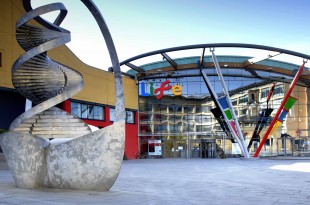Today's post comes from Andy Lloyd, Head of Special projects at the International Centre for Life Trust. This study is an evaluation of the impact that the Centre for Life in Newcastle upon Tyne has had and is an example of principle three of the Charter.
The Centre for Life opened at the start of the new millennium with a combination of research, public engagement, education and business all located on a single city-centre site. Our public science centre has developed a strong reputation for the quality of its engagement work, but our sector as a whole suffers from a lack of robust metrics for impact. In 2012 we joined with 16 international centres to develop an impact study tool that could be deployed across many countries. Led by Professor John Falk, of Oregon State University, this study has given us the first evidence of the relationship between participation in activities in a science centre and the wider perception of science in society’.
Every year, over 20 million children and adults of all backgrounds visit science and discovery centres in the UK, joining hundreds of millions of similar visitors across the world. Although science centres have long asserted that they play a critical role in supporting the science learning of the public, comprehensive data to support this claim is limited. Some evidence exists (e.g., ASDC, 2008; ASTC, ND; Bell et al., 2009; Falk & Needham, 2011; McCreedy & Dierking, 2013), but most investigations have involved self-selected populations, reflect a single institution or have other factors making it difficult to extrapolate the results to the whole sector. Robust and unequivocal evidence is limited, and little comprehensive international data exist on the topic.
The Centre for Life, in Newcastle upon Tyne, is one of the “millennium generation” of English science centres, situated in a landmark building in the city centre with a remit to make science engaging and accessible to everyone. It forms a “science village”, housing medical researchers from NewcastleUniversity, NHS clinics and biotechnology businesses alongside the public science centre and education facilities. Since May 2000 the science centre has welcomed around 220,000 people through its doors annually. In its first decade of operation it has evolved from a start-up enterprise to a mature organisation, learning from its peers and from user evaluation. It takes an evidence-based approach to the development of its programmes and exhibitions, applying lessons from basic learning research as well as museum and science centre studies. It has built up a body of anecdotal impact evidence, alongside a limited pool of quantitative studies, from the first few years of delivering science engagement activities.
In late 2012 an international consortium of 17 science centres in 13 countries was formed by a group of CEOs looking to dramatically improve the sector’s evidence base. The Centre for Life was the sole UK participant. The common interest was a desire to understand their centre’s impact on their local community, combined with an interest to see whether any aspects of impact are shared across all science centres. The group wished to build on the work of John Falk and Mark Needham, of OregonStateUniversity, who had studied the impact of the CaliforniaScienceCenter on the science literacy of the population of Los Angeles. The partner institutions invested their own funds in the research programme, supporting the design of a common research instrument and the collation and analysis of the resulting data set.
The International Science Centre Impact Study (ISCIS) surveyed over 13,000 individuals to better understand how experiences at science centres influenced adults’ and youth’s knowledge and understanding of science; interest in and engagement with science (in school and out-of-school); likelihood of pursuing careers or hobbies related to science; creativity; and problem-solving skills. Each partner was responsible for local data collection using the common approach of the whole group. The Centre for Life surveyed adults and teenagers (aged 14/15) across the five local authority areas of Tyne and Wear, in public locations and schools, to produce a sample of 961 members of the local community.
"Preliminary results suggest that findings from this study will not only help to make the case for the global value of science centers, but also enrich the field through a more detailed understanding of how a range of important cognitive, affective, and behavioural science outcomes are influenced by specific science centre experiences and demographics".
John H. Falk, Sea Grant Professor of Free-Choice Learning, Oregon State University
References - i.e. weblinks, associated research etc:
ASDC (as Ecsite-uk). (2008). Inspiration, engagement, and learning: The value of science and discovery centres in the UK, Working towards a benchmarking framework. Retrieved from www.sciencecentres.org.uk/reports/downloads/inspiration-engagement-learning-the-value-of-science-discovery-centres-in-the-uk.pdf
ASTC. (ND). The impact of science centers/museums on their surrounding communities: Summary report. Retrieved from www.astc.org/resource/case/Impact_Study02.pdf
Bell, P., Lewenstein, B., Shouse, A., & Feder, M. (2009). Learning science in informal environments: People, places, and pursuits. Washington, DC: National Academies Press.
Falk, J.H., Dierking, L.D., Needham, M.D. & Prendergast, L. (2013). Science Centers Make a Difference: Results from the InternationalScienceCenter Impact Study. Dimensions, Nov-Dec 2013, Washington DC, ASTC. Retrieved from www.astc.org/blog/category/astc-dimensions/dimensions-2013/
Falk, J.H., & Dierking, L.D. (2013). The museum experience revisited.Walnut Creek, CA: LeftCoast Press.
Falk, J.H., & Needham, M. (2011). Measuring the impact of a science center on its community. Journal of Research in Science Teaching, 48(1), 1–12.
Falk, J.H., & Needham, M. (2013). Factors contributing to adult STEM knowledge. Journal of Research in Science Teaching, 50(4), 431–452.
McCreedy, D., & Dierking, L.D. (2013). Cascading influences: Long-term impacts of informal STEM programs for girls. Philadelphia, PA: FranklinInstituteScienceMuseum Press.
Rothman, K. (2002). Epidemiology: An Introduction. New York, NY: John Wiley and Sons.

Leave a comment